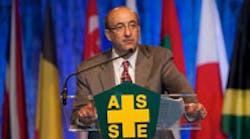“We want you to hear from us first that OSHA is back and we are a strong regulatory agency first and foremost,” Michaels told ASSE attendees. He explained that the agency is working “to make fundamental changes to secure safe workplaces” and stressed that OSHA’s goal is not to punish or react, but to encourage employers to plan, prevent and protect.
First, Michaels gave a rundown of some of OSHA’s priorities and actions over the past months, including: moving more personnel into enforcement; hiring additional standards writers and inspectors; developing a Severe Violator Enforcement Program; conducting expanded evaluations of all state plans and enforcement programs; making the agency more accessible; taking the time to listen to stakeholders; and more.
Sitting squarely at the top of Michaels’ priority list for the future is the Injury and Illness Prevention Program standard. This standard, he said, would require employers to identify and remediate hazards and then fix them. He added that such a standard “could change workplace health and safety on level we haven’t seen since [the 1970] OSH Act.”
Michaels also covered the following areas:
- Incentive programs – “In too many cases, workplace safety incentive programs are doing more harm than good by concealing injuries,” he said. “We don’t think those programs are effective at preventing injuries, we think they are effective of hiding injuries.” Michaels explained that good incentive programs reward positive work behaviors, such as reporting near misses and abating hazards.
- Recordkeeping – “It’s now time to move beyond pencil and paper to record workplace injuries and illnesses. We need to implement modern data collection system,” Michaels said. During a press conference following the session, Michaels added that this is his No. 2 priority following the Injury and Illness Prevention Program. The agency recently held stakeholder meetings on this issue.
- Penalties and criminal liability – “As long as OSHA penalties remain at these levels, recalcitrant employers view this [OSHA fines] as just another cost of business,” Michaels said. OSHA needs more power to penalize employers, which means larger fines and criminal penalties. The Protecting America’s Worker Act, if passed, would raise penalties, increase whistleblower protections and expand the rights of victims and victims’ families.
- Permissible Exposure Limits (PELs) –“Frankly, many of these [outdated] PELs are an embarrassment to us,” Michaels said. “Previously, OSHA had not taken leadership on this issue, and I think we need to.” He said that working through every individual chemical will take “an extremely long time” and that even streamlining the regulatory process will not be enough to create PELs for the thousands of chemicals out there. “We want to work with you and other organizations to take a different approach to this,” he said.
- Language barriers – Michaels stressed that employers must provide safety and health information and training in a language the workers can understand. OSHA recently held a 2-day National Action Summit for Latino Worker Health and Safety to seek new and effective ways to help protect these workers.
- Distracted driving –While OSHA doesn’t intend to issue a standard on distracted driving, Michaels stressed that every workplace should include a texting-while-driving ban as part of the health and safety program.
- Combustible dust standard –Michaels called this a “very complex standard” and said it “will take us some time to get there.” The agency will hold its first-ever virtual stakeholder meeting on a combustible dust standard on June 28.
In response to a question concerning reinstating an MSD column on the OSHA 300 log, Michaels stated that this is not the first step to an ergonomics standard. Instead, this information can lead employers to recognize, examine and then abate hazards, he said.
BP Oil Spill Response
As part of a team with the U.S. Coast Guard, NIOSH, EPA and other government agencies, OSHA is working with BP to help ensure the safety of workers in the Gulf region during oil spill cleanup operations. Michaels has traveled to the Gulf region twice within the last 6 weeks for this purpose. He said workers face hazards including the risk of heat stress; falls; drowning; fatigue; noise; and exposure to oil, dispersants, cleaning products or other chemicals.
“We have ability to issue citations if we want to, but our objective is to protect workers, not punish BP,” Michaels said. During the press conference, however, he clarified that “enforcement is not off the table.”
Michaels also acknowledged that the agency is facing some very tough issues, such as what types of PPE should be given to workers. Right now, for example, OSHA is not recommending the use of respirators for cleanup workers, but the agency is considering new information and challenges every day on this issues and others.
“We can agree that the potential for disaster in this situation was grossly underestimated,” Michaels said of the BP oil spill. “We can take this back to our workplaces. If the consequences from a single failure can be catastrophic … we need to recognize that past injury rates are poor indicators of future events.”
Finally, Michaels encouraged safety professionals to speak up at stakeholder meetings and in Web chats and to “tell OSHA how to do its job right.”
“Don’t be complacent,” he said. “Speak up, write a letter, send a message, be heard – make your experience and expertise be heard not just in your workplace but in Washington, as well,” he said. “Change has to come to all of us working together, locking arms, stiffening our resolve and moving forward to support reform.”
“[Secretary of Labor] Solis and I know how hard you work and we appreciate your accomplishments,” Michaels told ASSE attendees. “Give yourself a hand. You are workplace heroes for safety and health, every one of you, and we appreciate your work.”


